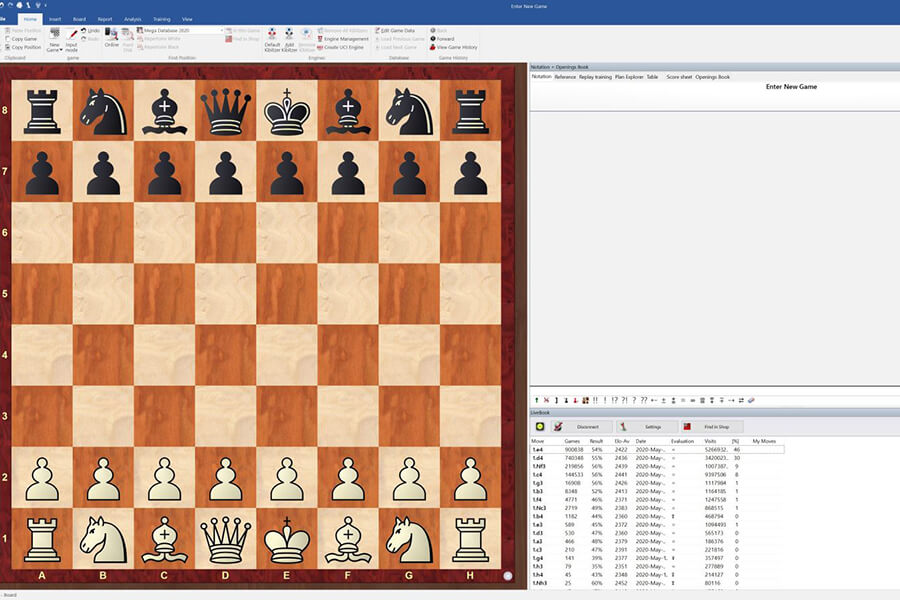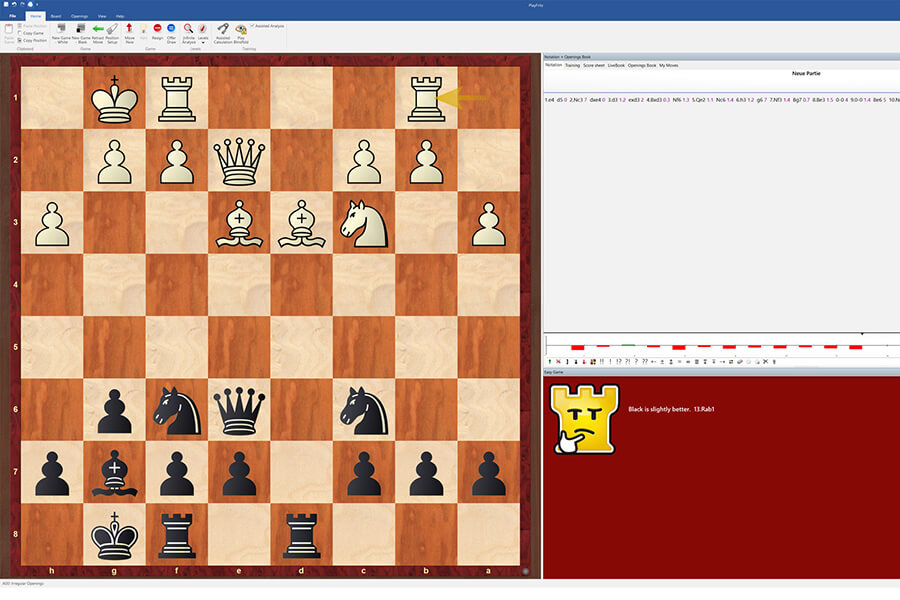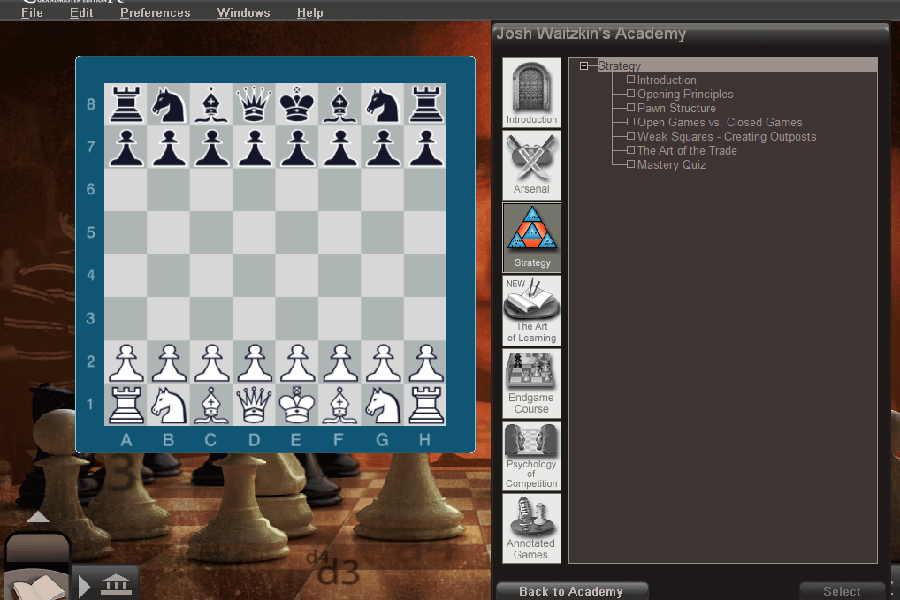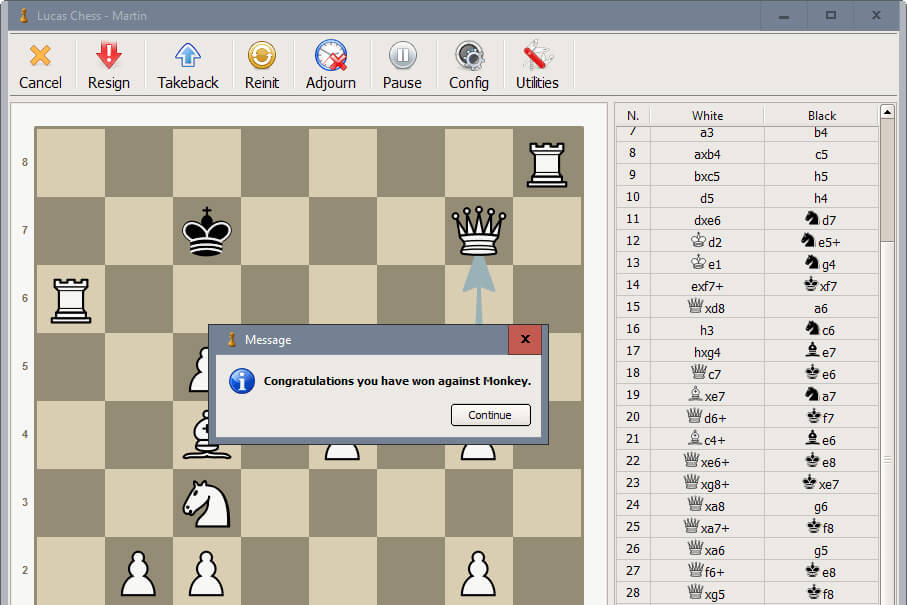No products in the cart.
Chess Rules & Instructions
Best 5 Chess Training Softwares
Table of Contents
Function of Chess Training Software
Chess training software programs typically offer a range of functions and features to help players improve their chess skills. Here are some common functions you can find in chess training software:
1. Chess Database: Many chess training software programs provide a comprehensive database of chess games. These databases allow users to search, explore, and study games played by top players, historical games, or games in specific openings or positions.
2. Game Analysis: Chess training software often includes powerful analysis tools that allow users to import or input their own games and analyze them move by move. These tools can identify inaccuracies, mistakes, and blunders, providing feedback and suggesting improvements.
3. Tactical Training: Tactical puzzles are a fundamental part of chess training. Chess training software often includes a tactics training module, presenting users with various puzzles and positions where they need to find the best moves or combinations.
4. Positional Training: Some chess training software focuses on positional understanding and strategic concepts. They provide lessons, examples, and interactive exercises to help users develop their understanding of pawn structures, piece placement, planning, and other positional elements.
5. Opening Preparation: Many software programs offer features for opening preparation. They provide opening books, databases of opening moves and variations, and tools to analyze and explore different opening lines. This allows users to study and prepare openings for their games.
6. Endgame Study: Endgame training is crucial for improving chess skills. Chess training software often includes features that focus on endgame positions, principles, and techniques. Users can study theoretical endgames, practice endgame puzzles, or analyze their own endgame positions.
7. Training Courses and Lessons: Some software programs provide structured training courses or interactive lessons covering various chess topics. These courses may cover fundamental concepts, specific openings, tactical themes, positional ideas, and other aspects of the game.
8. Play Against Computer: Chess training software usually includes a feature that allows users to play against a computer chess engine. Users can adjust the difficulty level of the engine to match their skill level and practice their skills in real-game scenarios.
These functions may vary depending on the specific chess training software program. Users can choose software that aligns with their training goals and preferences to enhance their chess skills and knowledge.
Top 5 Chess Training Software
ChessBase
ChessBase is a popular and comprehensive chess database and training software developed by ChessBase GmbH. It is widely used by chess players, professionals, and enthusiasts for studying, analyzing, and organizing chess games and related information. Here’s some information about ChessBase:
1. Database and Game Management: ChessBase provides a vast database of chess games from various sources, including top-level tournaments, historical games, and personal collections. Users can search, sort, and filter games based on players, openings, positions, and other criteria. The software allows for efficient organization, annotation, and categorization of games for easy retrieval.
2. Game Analysis and Engine Integration: ChessBase offers advanced analysis tools that enable users to analyze games move-by-move, visualize variations, and evaluate positions. Users can integrate powerful chess engines, such as Fritz, Houdini, or Stockfish, for real-time analysis and assistance in evaluating positions and suggesting moves.
3. Opening Preparation: ChessBase supports opening preparation by providing access to extensive opening databases and opening trees. Users can explore opening moves, variations, and statistics, study annotated games, and analyze specific positions to prepare for their own games and build an opening repertoire.
4. Training and Learning Resources: ChessBase includes a variety of training and learning features. It offers interactive training exercises, tactical puzzles, and video lessons by renowned players and trainers. The software also allows users to create and study opening repertoires, practice endgames, and study annotated games to improve their chess skills and knowledge.
5. Publishing and Reading: ChessBase acts as a platform for publishing and reading chess-related content. ChessBase users can publish their own games, articles, and analysis, and share them with the chess community. The software also supports the reading of various chess books and publications in digital format.
6. Online Integration: ChessBase provides online integration, allowing users to access and synchronize their databases, games, and training materials across multiple devices. It also offers online features such as playing and watching live games, participating in online tournaments, and connecting with other chess players through the ChessBase community.
ChessBase has become a go-to software for serious chess players, trainers, and journalists due to its extensive features, user-friendly interface, and comprehensive database. Its powerful analysis tools, training resources, and vast collection of games make it a valuable tool for studying, analyzing, and enjoying the game of chess.
Fritz Chess
Fritz Chess is a well-known and highly regarded chess engine and playing software developed by ChessBase. It is designed to provide a challenging opponent for players of all skill levels and offers a range of features and functions. Here’s some information about Fritz Chess:
1. Playing Strength: Fritz Chess is known for its strong playing strength. The software incorporates a powerful chess engine that uses advanced algorithms and evaluation techniques to make strong moves and decisions. The engine’s playing level can be adjusted to match the skill level of the user, making it suitable for beginners, intermediate players, and even grandmasters.
2. Analysis and Training: Fritz Chess includes robust analysis tools that allow users to analyze their own games or positions. The software provides detailed evaluations, suggested moves, and alternative variations to help users understand and improve their play. It also offers interactive training features, such as tactical exercises and endgame training, to enhance chess skills.
3. Opening Preparation: Fritz Chess supports opening preparation with access to extensive opening databases and opening book options. Users can explore opening moves, variations, and statistics, study annotated games, and analyze specific positions to prepare for their own games and build a solid opening repertoire.
4. User Interface and Visualization: Fritz Chess provides a user-friendly interface with intuitive navigation and customizable settings. The software offers various visual options, such as different board styles, piece sets, and 3D graphics, to personalize the chess-playing experience.
5. Online Play and Integration: Fritz Chess allows users to play chess games online against opponents from around the world. It supports connecting to popular online chess platforms and provides integration with ChessBase’s Playchess server, where users can join tournaments, watch live games, and participate in interactive events.
6. Integration with ChessBase: Fritz Chess is closely integrated with the ChessBase software ecosystem. Users can easily import and export games, databases, and analysis between Fritz Chess and other ChessBase products. This integration allows for seamless access to extensive databases, training materials, and additional features available in ChessBase.
Fritz Chess has been a popular choice for chess enthusiasts seeking a challenging opponent and comprehensive analysis tools. Its strong playing strength, user-friendly interface, and integration with ChessBase make it a valuable tool for studying, training, and enjoying the game of chess.
Chessmaster
Chessmaster is a well-known chess software program that was developed by Ubisoft and originally released in 1986. It has been widely regarded as one of the most popular and comprehensive chess software packages available. While the latest version available during my knowledge cutoff is Chessmaster 11, released in 2007, it’s worth noting that there may have been newer releases since then. Here is some information about Chessmaster:
1. Playing Strength: Chessmaster is renowned for its strong playing strength. The software includes a powerful chess engine that offers multiple difficulty levels, allowing players of all skill levels to find an appropriate challenge. The engine’s playing style can be adjusted to match the user’s preferences, ranging from aggressive to defensive play.
2. Interactive Tutorials and Training: Chessmaster offers a variety of interactive tutorials and training features designed to improve a player’s chess skills. These include lessons on tactics, strategies, openings, and endgames, as well as practice exercises and challenges to reinforce learning.
3. Analysis and Coaching: Chessmaster provides extensive analysis tools to help players analyze their games and positions. The software offers detailed evaluations, suggested moves, and alternative variations. In addition, Chessmaster can provide coaching during games, offering advice and warnings to help players make better decisions.
4. Database and Library: Chessmaster includes a large database of annotated games, allowing users to study and analyze the games of top players. The software also features a library of historical games, including famous encounters from the past, which can be explored and studied.
5. Play Modes and Multiplayer: Chessmaster offers various play modes, including regular games, tournaments, and puzzle challenges. The software supports multiplayer functionality, allowing players to compete against others over the internet or play against the AI with adjustable difficulty levels.
6. Interactive Features: Chessmaster incorporates interactive features to enhance the overall experience. This includes a 3D chess set with customizable board and piece styles, different playing environments, and the ability to view games from multiple angles.
It’s worth noting that while Chessmaster has been a popular and widely used chess software, updates and newer versions may have been released since my knowledge cutoff in September 2021. To obtain the most up-to-date information on Chessmaster, I recommend checking the official Ubisoft website or reputable gaming and software sources.
Komodo
Komodo is a highly regarded chess engine known for its strength and competitive performance in computer chess tournaments. Developed by chess programmer Don Dailey and computer scientist Mark Lefler, Komodo has achieved remarkable success and has been consistently ranked among the top chess engines in the world. Here is some information about Komodo:
1. Playing Strength: Komodo is renowned for its exceptional playing strength. It employs advanced algorithms and evaluation techniques to make strong and strategic moves. The engine’s playing level can be adjusted to suit players of various skill levels, making it suitable for beginners, intermediate players, and even grandmasters.
2. Evaluation and Search Algorithms: Komodo utilizes a combination of traditional evaluation factors, such as piece values, pawn structure, king safety, and mobility, with more modern and sophisticated evaluation techniques. It also employs an efficient and powerful search algorithm that explores millions of positions per second to determine the best move.
3. Opening Book and Opening Preparation: Komodo includes a well-developed opening book that provides a range of opening moves and variations. It can be used to study and prepare openings, analyze specific positions, and test opening lines against the engine. Komodo’s opening book is continually updated and improved based on ongoing research and analysis.
4. Analysis and Training: Komodo offers extensive analysis features to help users improve their game. It provides detailed evaluations, suggested moves, and alternative variations for analyzing positions and games. Additionally, Komodo can assist with game analysis, tactical puzzles, and endgame studies, providing valuable insights and guidance to players.
5. Tournament Performance: Komodo has a strong track record in computer chess tournaments and has achieved notable success. It has won multiple editions of the prestigious Top Chess Engine Championship (TCEC) and has consistently ranked among the top contenders in other computer chess competitions.
6. Integration with Chess Software: Komodo can be integrated into various chess software and user interfaces, allowing users to utilize its engine for analysis, game play, and training. It can be used with popular chess GUIs (Graphical User Interfaces) such as ChessBase, Arena, or SCID, enhancing the overall chess experience.
Komodo’s strength, competitiveness, and continuous development have made it a highly respected chess engine among chess players and computer chess enthusiasts. Its powerful analysis capabilities, strong tournament performance, and integration options make it a valuable tool for studying, analyzing, and playing chess.
Lucas Chess
Lucas Chess is a popular and free open-source chess training software developed by Lucas Monge. It is designed to provide a comprehensive set of tools and features for chess learning, practice, and improvement. Here is some information about Lucas Chess:
1. Training and Practice: Lucas Chess offers various training modes and exercises to help players improve their chess skills. It includes tactical puzzles, endgame practice, and positional training exercises. Users can customize the difficulty level and choose specific themes or types of exercises to focus on.
2. Chess Engines and Analysis: Lucas Chess integrates with several chess engines, such as Stockfish, to provide strong analysis and evaluation of positions. Users can analyze their games, receive move suggestions, and explore alternative variations using the integrated engines. The software also supports UCI engine protocols, allowing users to add their preferred chess engine.
3. Opening Training and Study: Lucas Chess provides tools for opening training and study. It includes an opening database with a wide range of opening moves and variations. Users can practice and study different openings, create their opening repertoire, and analyze opening moves and ideas.
4. Play Against Computer: Lucas Chess allows users to play against the computer at various difficulty levels. The software offers a customizable AI opponent, allowing players to adjust the strength and playing style of the computer. This feature enables users to practice and play games against a challenging opponent.
5. Learning Material: Lucas Chess includes a collection of learning material, including classic chess books and tutorials. Users can study annotated games, explore famous chess positions, and access instructional material to enhance their understanding of chess concepts and strategies.
6. User Interface and Customization: Lucas Chess features a user-friendly interface with customizable settings and options. Users can personalize the chessboard appearance, piece styles, and colors according to their preferences. The software supports multiple languages, making it accessible to a broader user base.
7. Community and Online Integration: Lucas Chess has an active community of users who share resources, discuss chess-related topics, and provide support. The software also integrates with online platforms such as lichess.org, allowing users to participate in online chess games, puzzles, and tournaments.
Lucas Chess has gained popularity for its comprehensive set of features, user-friendly interface, and the fact that it is freely available as an open-source software. Its focus on training, customization options, and learning materials make it a valuable tool for chess enthusiasts of all skill levels who want to improve their game.






